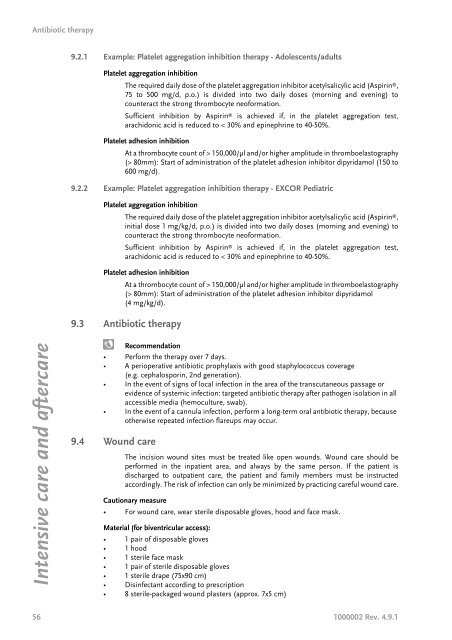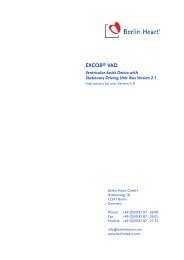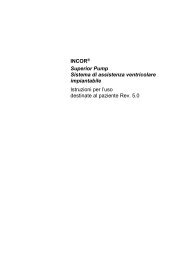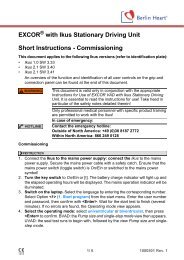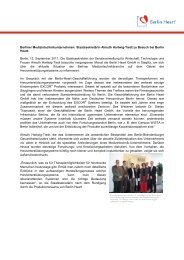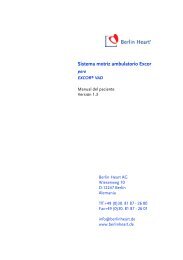Instructions for use: Ikus - Berlin Heart
Instructions for use: Ikus - Berlin Heart
Instructions for use: Ikus - Berlin Heart
Create successful ePaper yourself
Turn your PDF publications into a flip-book with our unique Google optimized e-Paper software.
Antibiotic therapy<br />
Intensive care and aftercare<br />
9.2.1 Example: Platelet aggregation inhibition therapy - Adolescents/adults<br />
Platelet aggregation inhibition<br />
The required daily dose of the platelet aggregation inhibitor acetylsalicylic acid (Aspirin ® ,<br />
75 to 500 mg/d, p.o.) is divided into two daily doses (morning and evening) to<br />
counteract the strong thrombocyte neo<strong>for</strong>mation.<br />
Sufficient inhibition by Aspirin ® is achieved if, in the platelet aggregation test,<br />
arachidonic acid is reduced to < 30% and epinephrine to 40-50%.<br />
Platelet adhesion inhibition<br />
At a thrombocyte count of > 150,000/μl and/or higher amplitude in thromboelastography<br />
(> 80mm): Start of administration of the platelet adhesion inhibitor dipyridamol (150 to<br />
600 mg/d).<br />
9.2.2 Example: Platelet aggregation inhibition therapy - EXCOR Pediatric<br />
Platelet aggregation inhibition<br />
The required daily dose of the platelet aggregation inhibitor acetylsalicylic acid (Aspirin ® ,<br />
initial dose 1 mg/kg/d, p.o.) is divided into two daily doses (morning and evening) to<br />
counteract the strong thrombocyte neo<strong>for</strong>mation.<br />
Sufficient inhibition by Aspirin ® is achieved if, in the platelet aggregation test,<br />
arachidonic acid is reduced to < 30% and epinephrine to 40-50%.<br />
Platelet adhesion inhibition<br />
At a thrombocyte count of > 150,000/μl and/or higher amplitude in thromboelastography<br />
(> 80mm): Start of administration of the platelet adhesion inhibitor dipyridamol<br />
(4 mg/kg/d).<br />
9.3 Antibiotic therapy<br />
Recommendation<br />
• Per<strong>for</strong>m the therapy over 7 days.<br />
• A perioperative antibiotic prophylaxis with good staphylococcus coverage<br />
(e.g. cephalosporin, 2nd generation).<br />
• In the event of signs of local infection in the area of the transcutaneous passage or<br />
evidence of systemic infection: targeted antibiotic therapy after pathogen isolation in all<br />
accessible media (hemoculture, swab).<br />
• In the event of a cannula infection, per<strong>for</strong>m a long-term oral antibiotic therapy, beca<strong>use</strong><br />
otherwise repeated infection flareups may occur.<br />
9.4 Wound care<br />
The incision wound sites must be treated like open wounds. Wound care should be<br />
per<strong>for</strong>med in the inpatient area, and always by the same person. If the patient is<br />
discharged to outpatient care, the patient and family members must be instructed<br />
accordingly. The risk of infection can only be minimized by practicing careful wound care.<br />
Cautionary measure<br />
• For wound care, wear sterile disposable gloves, hood and face mask.<br />
Material (<strong>for</strong> biventricular access):<br />
• 1 pair of disposable gloves<br />
• 1 hood<br />
• 1 sterile face mask<br />
• 1 pair of sterile disposable gloves<br />
• 1 sterile drape (75x90 cm)<br />
• Disinfectant according to prescription<br />
• 8 sterile-packaged wound plasters (approx. 7x5 cm)<br />
56 1000002 Rev. 4.9.1


